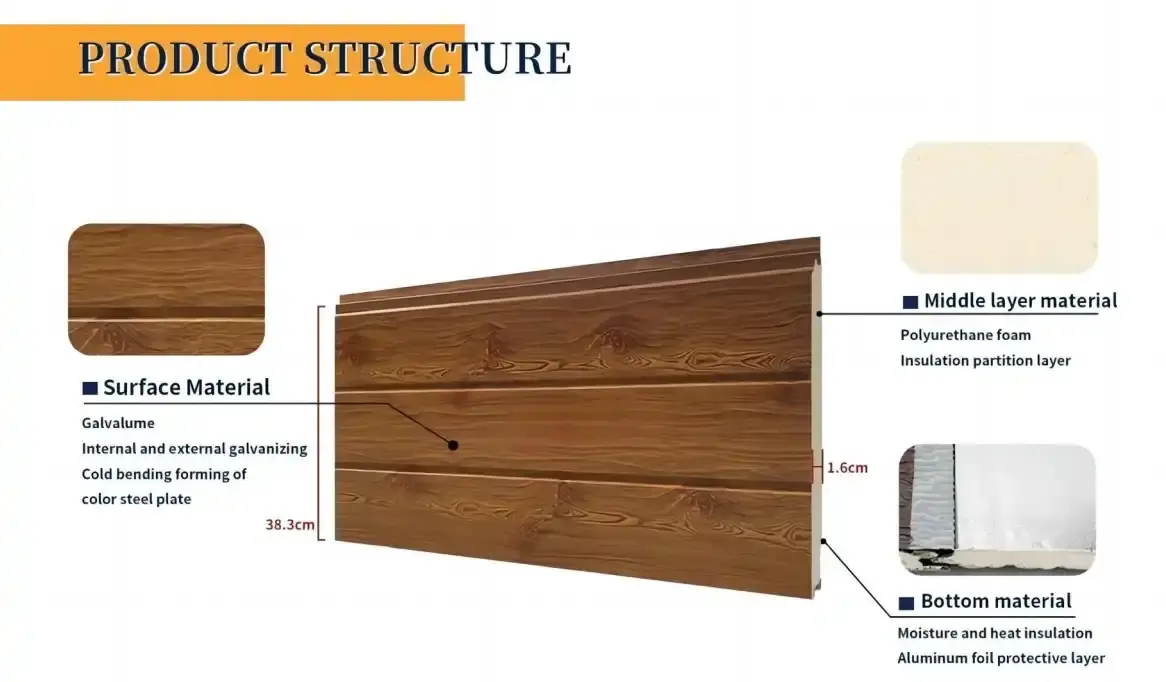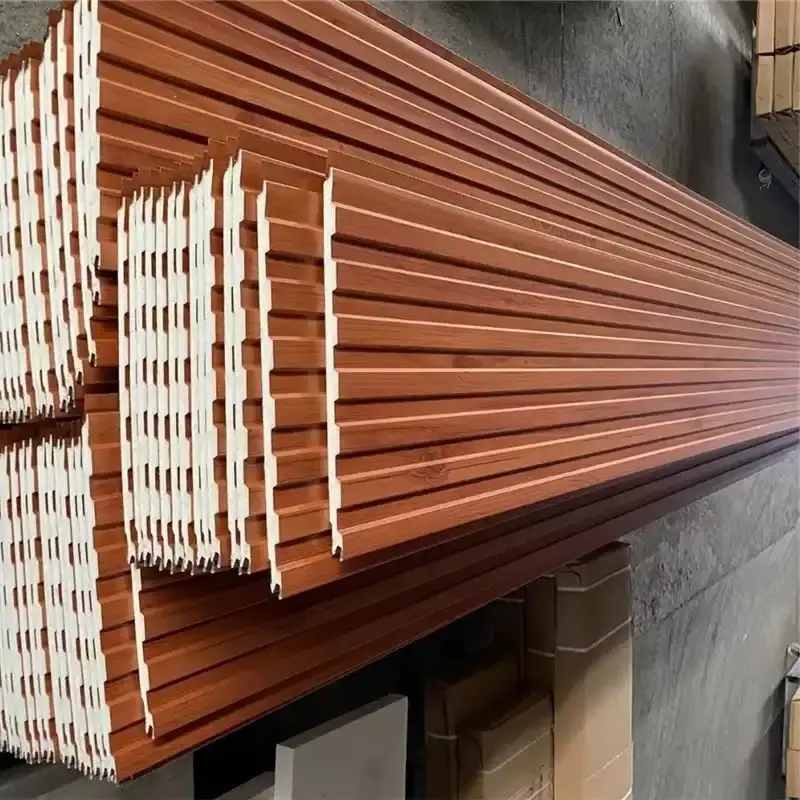Grasping Waterproof Exterior Wall Panels
What Are Waterproof Exterior Wall Panels?
Waterproof exterior wall panels are specialized building materials designed to protect structures from moisture infiltration and water damage. These panels serve as a barrier between the interior of a building and the external environment, effectively keeping water out while allowing the building to "breathe." Waterproof exterior wall panels are typically made from materials that are inherently water-resistant or treated with special coatings to enhance their waterproofing properties.
The composition of waterproof exterior wall panels can vary, but common materials include:
- Fiber cement
- Metal (such as aluminum or steel)
- Composite materials
- High-density polyethylene (HDPE)
- Polyvinyl chloride (PVC)
Each of these materials offers unique benefits in terms of durability, aesthetics, and performance in high-humidity environments. For instance, fiber cement panels are known for their strength and resistance to rot, while metal panels with protective coatings can offer excellent corrosion resistance.
Key Features of Waterproof Exterior Wall Panels
Waterproof exterior wall panels possess several key features that make them suitable for high-humidity environments:
- Water Resistance: The primary feature of these panels is their ability to repel water and prevent moisture infiltration.
- Durability: They are designed to withstand harsh environmental conditions, including high humidity, without degrading.
- Mold and Mildew Resistance: Many waterproof panels are treated or composed of materials that inhibit the growth of mold and mildew.
- Thermal Insulation: Some waterproof panels offer excellent thermal insulation properties, helping to regulate indoor temperatures.
- Aesthetic Versatility: These panels come in a variety of colors, textures, and finishes to suit different architectural styles.
- Low Maintenance: Due to their resilience, waterproof panels typically require minimal upkeep.
Benefits of Using Waterproof Exterior Wall Panels
Implementing waterproof exterior wall panels in high-humidity environments offers numerous advantages:
Protection Against Water Damage: These panels shield the building's structure from moisture-related issues such as rot, warping, and structural weakening.
- Energy Efficiency: Many waterproof panels provide insulation, reducing energy costs associated with heating and cooling.
- Longevity: By resisting water damage and decay, these panels can extend the lifespan of the building's exterior.
- Improved Indoor Air Quality: By preventing moisture infiltration, waterproof panels help maintain a healthier indoor environment, reducing the risk of mold-related health issues.
- Cost-Effectiveness: While the initial investment may be higher, the long-term savings in maintenance and repair costs can be substantial.
- Increased Property Value: A well-protected exterior can enhance the overall value and appeal of a property.
Types of Waterproof Exterior Wall Panels for High-Humidity Environments
Fiber Cement Panels
Fiber cement panels are a popular choice for waterproof exterior wall panels in high-humidity environments. These panels are made from a mixture of cement, sand, and cellulose fibers, resulting in a durable and moisture-resistant product. Key characteristics of fiber cement panels include:
- Exceptional Water Resistance: The cement-based composition naturally repels water.
- Dimensional Stability: These panels resist warping, swelling, or shrinking in humid conditions.
- Fire Resistance: Fiber cement is non-combustible, adding an extra layer of safety.
- Pest Resistance: Unlike wood, fiber cement doesn't attract termites or other wood-boring insects.
- Versatility: Available in a wide range of textures and colors, including wood-like finishes.
Fiber cement panels are particularly suitable for coastal areas or regions with frequent rainfall. They can withstand salt spray and high humidity without deteriorating, making them an excellent choice for long-term durability in challenging environments.
Metal Panels with Protective Coatings
Metal panels, particularly those made from aluminum or steel and treated with protective coatings, are another excellent option for waterproof exterior wall panels in high-humidity settings. These panels offer:
- Superior Corrosion Resistance: When properly coated, metal panels can resist rust and corrosion even in salt-laden air.
- Lightweight Yet Durable: Metal panels are easy to install and can withstand high winds and impacts.
- Energy Efficiency: Reflective coatings can help reduce heat absorption, improving energy efficiency.
- Low Maintenance: Metal panels are easy to clean and maintain their appearance over time.
- Design Flexibility: Available in various colors, finishes, and profiles to suit different architectural styles.
The key to the success of metal panels in high-humidity environments lies in their protective coatings. Advanced coatings such as fluoropolymer finishes (like PVDF) or powder coatings provide an additional layer of protection against moisture and UV radiation, ensuring the panels remain attractive and functional for years.
Composite Panels
Composite panels, often made from a combination of materials such as plastic and wood fibers or metal and polymer cores, offer unique advantages as waterproof exterior wall panels in humid conditions:
- Excellent Moisture Resistance: The synthetic components in composite panels provide superior water resistance.
- Thermal Insulation: Many composite panels offer built-in insulation properties.
- Lightweight: These panels are typically lighter than traditional materials, making installation easier.
- Durability: Resistant to rot, warping, and insect infestation.
- Low Maintenance: Composite panels often require minimal upkeep and can maintain their appearance for years.
- Eco-Friendly Options: Some composite panels are made from recycled materials, appealing to environmentally conscious consumers.
Composite panels can mimic the appearance of natural materials like wood or stone while offering superior performance in high-humidity environments. This makes them an attractive option for architects and homeowners looking to balance aesthetics with functionality.
Factors to Consider When Choosing Waterproof Exterior Wall Panels?
Climate and Environmental Conditions
When selecting waterproof exterior wall panels for high-humidity environments, it's crucial to consider the specific climate and environmental conditions of the location. Factors to evaluate include:
- Average Humidity Levels: Higher humidity requires panels with superior moisture resistance.
- Rainfall Patterns: Areas with frequent or heavy rainfall may benefit from panels with enhanced water-shedding properties.
- Temperature Fluctuations: Panels should be able to withstand thermal expansion and contraction without compromising their waterproof integrity.
- UV Exposure: In sunny, humid climates, panels with UV-resistant properties are essential to prevent degradation.
- Salt Exposure: Coastal areas require panels that can resist salt corrosion.
- Wind Loads: High-wind areas may need panels with greater structural strength.
By carefully assessing these environmental factors, you can choose waterproof exterior wall panels that are best suited to withstand the specific challenges of your location, ensuring long-term performance and protection.
Building Codes and Regulations
Adhering to local building codes and regulations is paramount when selecting waterproof exterior wall panels. Consider the following aspects:
- Fire Resistance Requirements: Many jurisdictions have specific fire rating requirements for exterior cladding.
- Wind Load Resistance: Ensure the panels meet or exceed local wind resistance standards.
- Energy Efficiency Standards: Some areas may require exterior cladding to meet certain insulation values.
- Environmental Regulations: Be aware of any restrictions on materials or finishes in your area.
- Installation Guidelines: Follow manufacturer and local code requirements for proper installation to maintain warranty and ensure performance.
Consulting with local building authorities or a qualified architect can help ensure your chosen waterproof exterior wall panels comply with all relevant regulations, avoiding costly mistakes or legal issues down the line.
Maintenance Requirements and Longevity
The long-term performance of waterproof exterior wall panels depends significantly on their maintenance requirements and overall longevity. Consider these factors:
- Cleaning Needs: Some panels may require regular cleaning to maintain their appearance and performance.
- Repainting or Refinishing: Determine how often the panels might need to be repainted or refinished to maintain their protective properties.
- Inspection Frequency: Regular inspections can help identify and address potential issues before they become serious problems.
- Repair Ease: Consider how easily damaged panels can be repaired or replaced.
- Warranty Coverage: Look for panels with comprehensive warranties that cover performance in high-humidity conditions.
- Expected Lifespan: Compare the projected lifespans of different panel types to determine the most cost-effective option over time.
- Opting for waterproof exterior wall panels with low maintenance requirements and long lifespans can significantly reduce the total cost of ownership and ensure consistent performance in challenging high-humidity environments.
Aesthetic Considerations
While performance is crucial, the aesthetic appeal of waterproof exterior wall panels should not be overlooked. Consider these aspects when evaluating the visual impact of your chosen panels:
- Color Options: Look for panels available in a range of colors that complement your building's design.
- Texture Varieties: Consider whether smooth, wood-grain, or other textured finishes best suit your architectural style.
- Panel Sizes and Patterns: The size and arrangement of panels can significantly impact the overall look of the building.
- Finish Durability: Ensure the chosen finish can maintain its appearance in high-humidity conditions without fading or degrading.
- Design Flexibility: Some panel systems offer greater flexibility in creating unique patterns or incorporating other design elements.
- Integration with Other Materials: Consider how the panels will visually interact with other exterior elements like windows, doors, and trim.
Conclusion
Selecting the right waterproof exterior wall panels for high-humidity environments is crucial for ensuring the longevity, efficiency, and aesthetic appeal of buildings. By understanding the unique properties of different panel types, such as fiber cement, metal with protective coatings, and composites, architects and builders can make informed decisions that best suit their specific needs. Considering factors like local climate conditions, building codes, maintenance requirements, and aesthetic preferences allows for a comprehensive approach to exterior cladding selection.
For expert guidance on selecting and implementing waterproof exterior wall panels for your specific project, don't hesitate to reach out to Weifang Sandong Building Materials Co., Ltd. Our team of specialists is ready to assist you in finding the perfect solution for your high-humidity environment needs. As a trusted waterproof exterior wall panels factory, Weifang Sandong is committed to providing high-quality, durable, and aesthetically advanced wall panel systems designed to perform in even the most demanding conditions. Contact us at info@sdqsc.com to explore our range of high-quality waterproof exterior wall panels and take the first step towards enhancing your building's protection and appearance.
FAQ
How do waterproof exterior wall panels contribute to energy efficiency?
Waterproof exterior wall panels can contribute to energy efficiency by providing an additional layer of insulation and preventing moisture infiltration, which can affect indoor temperature regulation. Many panels, especially composite types, have built-in insulation properties that help maintain consistent indoor temperatures, reducing the load on heating and cooling systems.
Are waterproof exterior wall panels suitable for all types of buildings?
While waterproof exterior wall panels are versatile and can be used on many building types, their suitability depends on specific architectural requirements, local building codes, and environmental conditions. They are particularly beneficial for structures in high-humidity areas, coastal regions, or locations prone to frequent rainfall.
How long do waterproof exterior wall panels typically last?
The lifespan of waterproof exterior wall panels varies depending on the material, quality, environmental conditions, and maintenance. High-quality panels from reputable manufacturers like Weifang Sandong Building Materials Co., Ltd. can last 30 years or more with proper care and installation.
References
1. Building Science Corporation. (2021). "Water Management in Exterior Wall Claddings."
2. National Institute of Building Sciences. (2022). "Whole Building Design Guide: Wall Systems."
3. American Society of Civil Engineers. (2020). "Minimum Design Loads and Associated Criteria for Buildings and Other Structures."
4. Journal of Building Engineering. (2021). "Performance of Exterior Wall Claddings in High-Humidity Environments."
5. International Code Council. (2022). "International Building Code."
